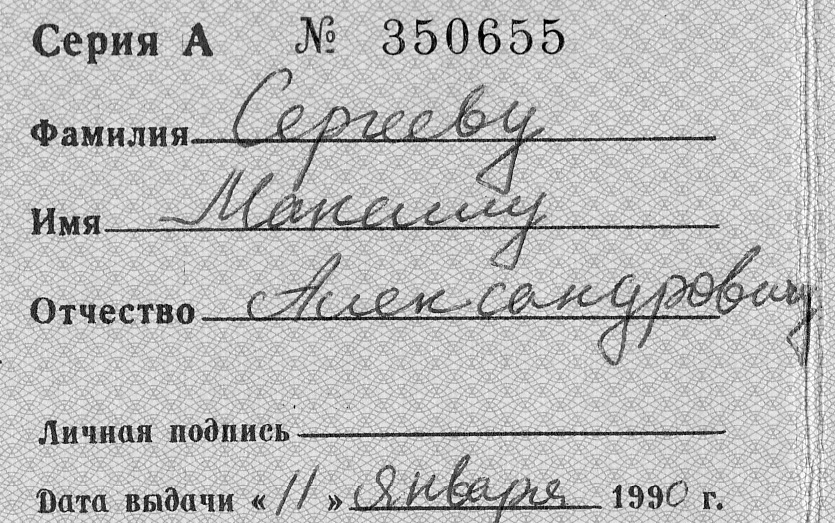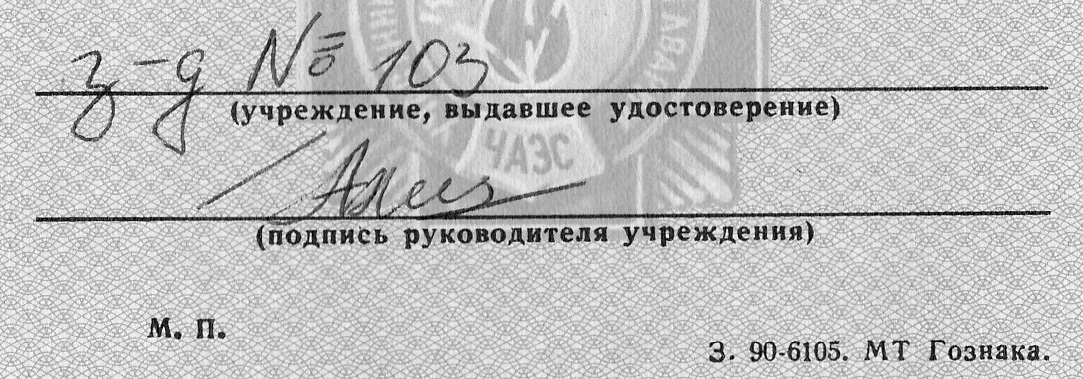Medal awarded to the "Chernobyl Liquidators" for Service at the Chernobyl Nuclear Disaster
The text on the cover states:

CERTIFICATE
The text on the top left interior states:

CERTIFICATE
participant
in the elimination of the
consequences of an accident
at the Chernobyl Nuclear Power Plant in 198 years.
The "4A3C" indicates "Chernobilskaya Nuclear Power Plant."
The text on the lower left of the document states:

Series A No. 350655
Surname
Name
Middle Name
Personal signature
Date Issued "11"
January 1990.
The text on the upper right of the document states:

The text on the bottom right of the document states:

(the institution that issued the
certificate)
(signature of the head of the institution)
M. P.
3. 90-6105. MT of Goznak.
The Chernobyl nuclear power plant, about 130 km (80 mi) north of Kiev in Ukraine, was the site of the world's worst nuclear-reactor disaster on Apr. 26, 1986 when the plant's No. 4 reactor exploded.
The accident occurred while an experiment was being conducted with the graphite-moderated reactor running, but its emergency water-cooling system turned off. A series of miscalculations permitted neutron buildup in one area of the core, where the nuclear reaction suddenly went out of control. The power surge shattered the fuel. This and a second steam-induced explosion blew the lid off the reactor, whose containment structure was not designed for such pressures. A third chemical explosion followed and scattered fragments caused further local fires.
The disaster killed 31 persons immediately or shortly thereafter and caused the immediate hospitalization of about 500 others.
Over the next few days, persons living within 30 km (19 mi) of the site were evacuated.
The force of the explosion and fire carried much of the radioactivity away from the site to relatively high altitudes, where it spread across the Northern Hemisphere. The heaviest fallout descended on the western Soviet Union and portions of Europe, where preventive steps were taken by several nations to protect food supplies. Data on worldwide effects of this fallout remain inconclusive.
Although heavily contaminated soil and trees were removed from the 30 km (19 mi) zone near the power plant, authorities acknowledged in 1990 that several million persons were still living on contaminated ground. The incidences of thyroid cancer, leukemia, and other radiation-related illnesses are higher than normal among this population.
At the plant itself, reactor No. 4 was entombed in concrete. Two of the three remaining reactors continued in operation, but a series of accidents at Chernobyl persuaded Ukraine's parliament in 1991 to press for a complete shutdown until another source of power for the region was developed.
The USSR was criticized for keeping the accident secret until radioactivity was discovered in Sweden, and then failed to disclose its extent. Pripyat, Chernobyl, and nearby towns were permanently evacuated as a result of the accident. The Ukraine has estimated that as many as 8,000 people died as a result of the accident and its cleanup; however, this number continues to be the subject of debate.
This medal is unique as it is the only medal in the world awarded for participation in a nuclear cleanup. The very first people to go to the nuclear hell were firefighters - they did not know about the danger and were told the radiation leak was minimal. They did not have any special protective clothing, only light gas masks. Many of them are already dead and many continue to die a slow and painful death.
Initially, the decision was to withhold information from the people. First responders were awarded regular Firefighter's Bravery medals. The disaster happened just before the regular 1st of May parade and thousands of people went out parading and breathing radioactive dust instead of staying home. Many Russians view this as yet another crime by the Party elite against the Soviet people.
Only after the wind blew the nuclear dust across the border were serious measures taken and special army units sent in.
When the medal was instituted it was awarded to everyone who paid with their lives and health for criminal stupidity and mistakes.
The medal was given with an award document. My copy is depicted above.
This particular document is unusual for a couple of reasons. Typically, Soviet medals are awarded by the government, and always at the Kremlin or in the local military commissariats.
Only the Chernobyl medal was awarded by Soviet factories or at the participant's place of work.
Soviet factories usually have names like "Bolshevik" "Skorokhod" etc. Only secret military factories have numbers. This particular document was awarded by factory #103.
This document is signed by someone for the factory director and not by the director himself. Additionally, it was not signed by the recipient.
The Chernobyl award document is designed to have a factory seal placed upon it. It is not present on this or most Chernobyl documents. A filled-in Chernobyl document is a rare find. Was this intended as disrespect to the award? Could it be that the issuing authorities didn't even bother to fill it in?
The
answers have not surfaced and mysteries continue to
surround the award.
Note:
Both the medal and the document are in my collection. I have
not had either tested for radiation and do not intend to.
Bibliography: Gould, Peter, Fire in the Rain (1990); Medvedev, Georgii, The Truth about Chernobyl (1991); Medvedev, Zhores, Legacy of Chernobyl (1990); Scherbak, Iurii, Chernobyl (1989). Some text and research courtesy of Alexei Merezhko.
Read more about the "Chernobyl Liquidators" on Wikipedia